INTRODUCTION
Cataract, characterized with the opacity on the crystalline lens, can markedly restrict the routine activities of patients, such as reading, writing, walking and eventually reduce the quality of life[1-3]. Cataract is the main cause of avoidable blindness[4-6]. Despite some recent advances in the field of cataract potential drug treatments, surgery is still acknowledged to be the most effective treatment option[7-10].
The cataract surgery has a long history and has advanced very quickly in the past decades[11-13]. Generally, there are several basic surgical types, including phacoemulsification (Phaco),extracapsular cataract extraction (ECCE), manual smallincision cataract surgery (MSICS), and in particular, Phaco is the most commonly-used type now[14-16].
The advances of cataract surgery are attributed to many excellent scientists and surgeons[17]. Thanks to their contributions, modern cataract surgery can be performed in a standardized way in both developed and developing countries,curing millions of suffering patients[18-20]. To our knowledge,this is the first study to quantify and analyze the most-cited papers about cataract surgery.
It is not easy to perfectly quantify the importance of a Scientific paper to ophthalmologists, so we take “citation” as a surrogate for the influence of a paper. A citation is one paper’s reference to another work, and thus acknowledges the contribution from this work. The citations would affect a journal’s impact factor (IF), which is determined by dividing the “number of citations in this year” by the “number of articles published in that journal in the preceding two years”. Thus, citation analysis can be used to determine the relative importance of a medical journal by means of the impact factor[21-22]. To our knowledge,we are the first to present the most influential papers in the field of cataract surgery. Our aim is to do a bibliometric analysis onthe 100 most-cited papers relevant to cataract surgery identified on Thomson Reuters Web of Knowledge through extensive search.
Table 1 The 100 most-cited papers

ESCRS: European Society of Cataract & Refractive Surgeons.
MATERIALS AND METHODS
A comprehensive literature search was performed to identify the 100 most-cited relevant papers from 1950 to 2016 on the Tho mason Reuters Web of Science (Science Citation Index Expanded) on 7th December 2016. The search terms were“cataract surgery”, “phacoemulsification”, “manual smallincision cataract surgery” or “MSICS”, “extracapsular cataract extraction” or “ECCE”. No limits were applied in the search and the results were ranked according to the citation frequency.Before further analysis of the papers, the authorships, titles,year of publications, countries, number of citations in total,number of citations in the latest 5y, average citation number per year (ACY), journals of publication, journals’ IF, main themes, and institutions of origin were recorded.
Statistical Analysis Pearson’s correlation analysis was performed to evaluate the correlation between the published year and the number of citations, including the total citations,latest 5y citations and ACY. The correlations between journal’s IF and the number of total citations were also assessed. The analyses were performed with SPSS 20.0. P values less than 0.05 in two-sides were considered to be statistically significant.
RESULTS
Citations, Publication Years The Web of Science literature search returned 10 761 full-length papers. The 100 most-cited papers and their numbers of citations are shown in Table 1.
The number of citations ranges from 85 to 281 for the top-100 papers, with a mean of 126. The oldest paper on the list was written by Irvine[23] in 1953 ranking fourth, whereas the other 99 papers were all published since 1980, with the 1990s being the decade with the largest number of publications as well as the most citations (Table 2, Figure 1).
Topics The topics listed in the top 100 papers were wideranging and covered almost every aspect of cataract surgery;however, there are several themes commonly seen in many of the papers. The most common topics are postoperative complications, clinical outcomes and the surgical techniques(Table 3). Among them, the 45 complication-associated papers contribute to the most citations of 5768. It is obvious that endophthalmitis is the most hot theme within various complications, such as post-capsular opacification,astigmatism or aberration. Not surprisingly, the top 2 mostcited papers on the list also focused on the prophylaxis against endophthalmitis[24-25]. These results suggest that endophthalmitis is one of the research hotspots attracting many ophthalmologists because of its terrible prognosis (Table 3)[26-28].
Authors Because most papers have more than one author,it is hard to identify the author of each paper who makes the leading contribution. Thus, we assume that the primary contributor is the author ranking in the first position[29]. We find that many authors are represented multiple times on the list,including J. C. Javitt, P. Desai, O. D. Schein, E.P. Steinberg, H.V. Gimbel, P. G. Montan and K. Hayashi (Table 4).
Countries Fourteen countries contribute to the 98 most-cited papers of cataract surgery. The top three countries of origin are the USA, UK and Japan, followed by Germany, Sweden,Canada, the Netherlands, Spain, Hungary, Austria, Australia,Israel, China and India (Table 5). Two papers focusing on the prophylaxis were done by the European Society of Cataract &Refractive Surgeons (ESCRS) and therefore excluded from the analysis of the countries.
Institutions Totally, 68 independent institutions of the first authors were credited among the 100 papers, with some listed in more than one single paper (Table 6). The institution that contribute the most citations was Johns Hopkins University with 1527 citations, and followed by Harvard Medical School with 621 citations.
Journals Moreover, the top-100 list involves 14 journals(Table 7) with the number of papers per journal ranging from 1 to 35. The most-represented journal is Ophthalmology with 35 papers, followed by Journal of Cataract and Refractive Surgery and American Journal of Ophthalmology with 24 and 13 papers respectively. These 3 journals also contribute the most citations, precisely 4207, 2917 and 1771.
Association The latest 5y citations and ACY were found to be significantly related with the published year (5y citations:r=0.615, P<0.001; ACY: r=0.657, P<0.001), whereas no association between the total number of citations and published year was found (r=0.045). The Pearson’s correlation analysis also shows that IF of journals had no significant effect on the number of total citations.
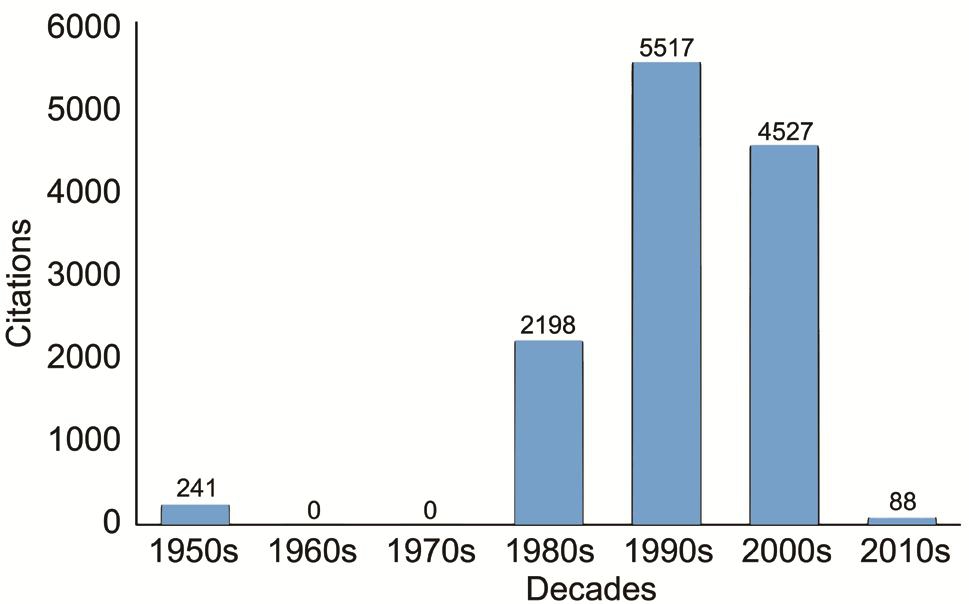
Figure 1 Citations of decades.
Table 2 Publication dates
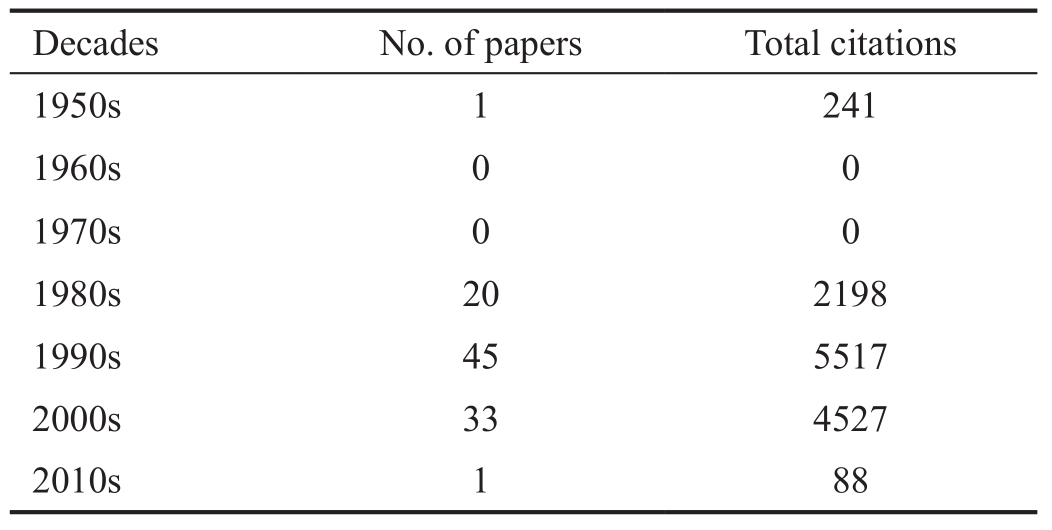
Table 3 Most popular topics
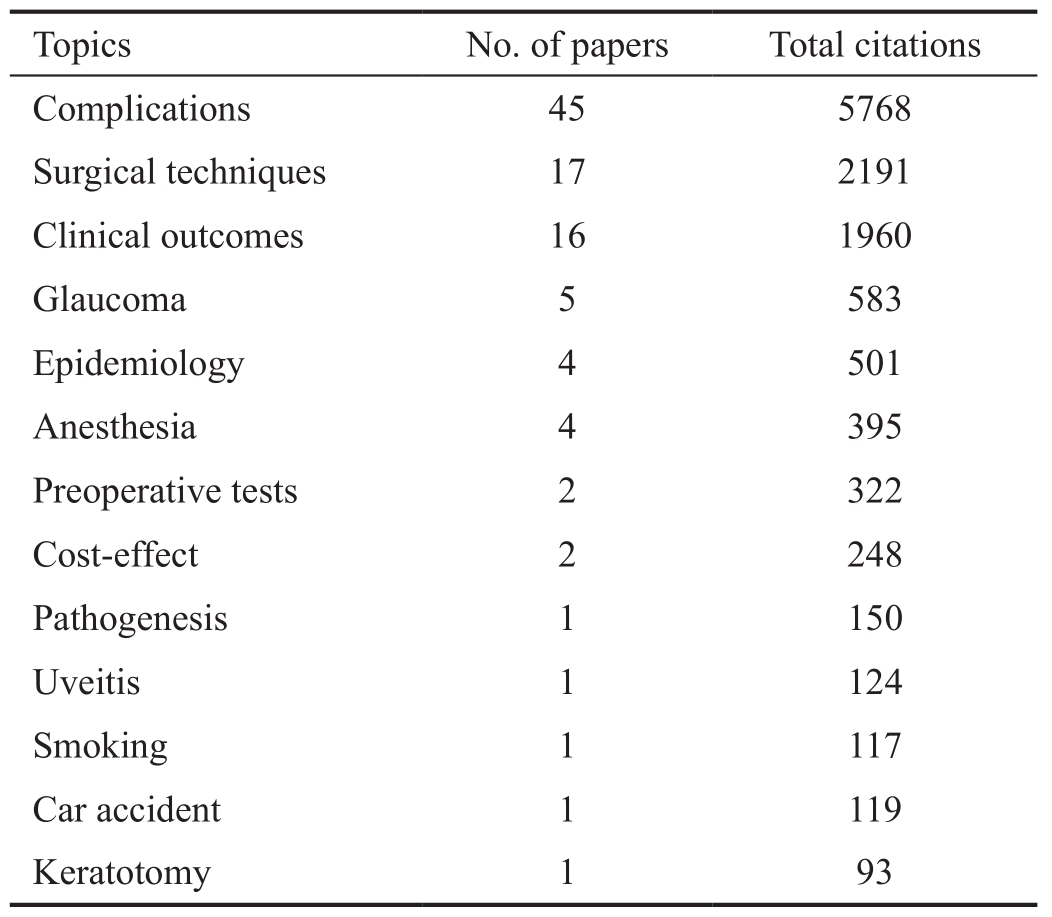
Table 4 Top 10 authors with most citations
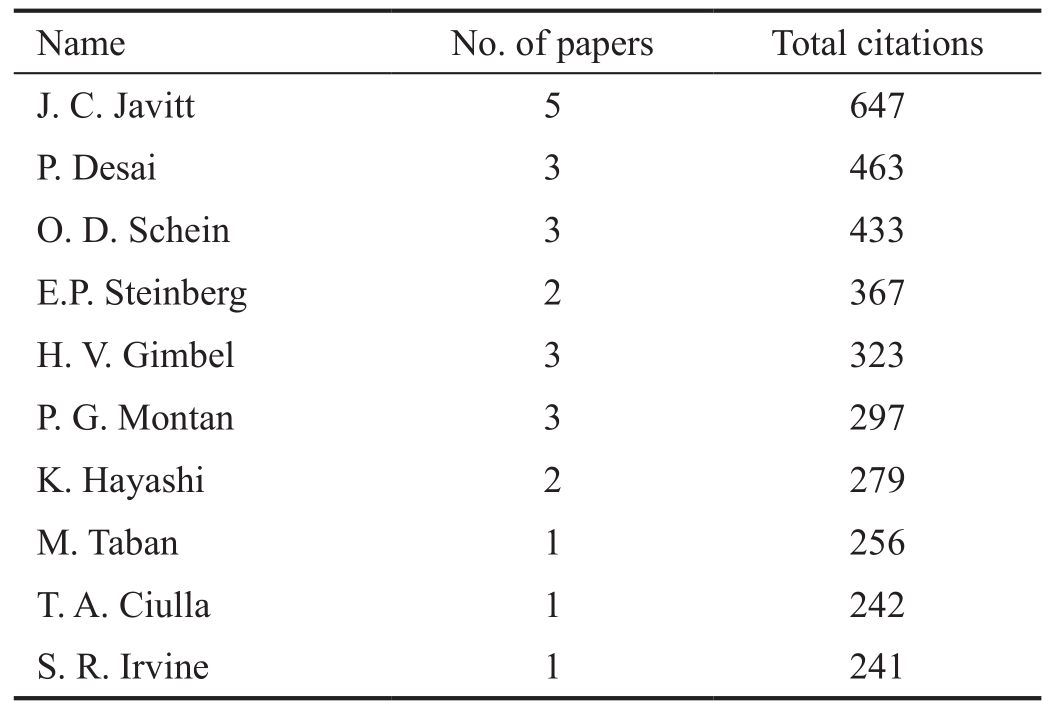
Table 5 Countries of publications

Table 6 Institutions of publications
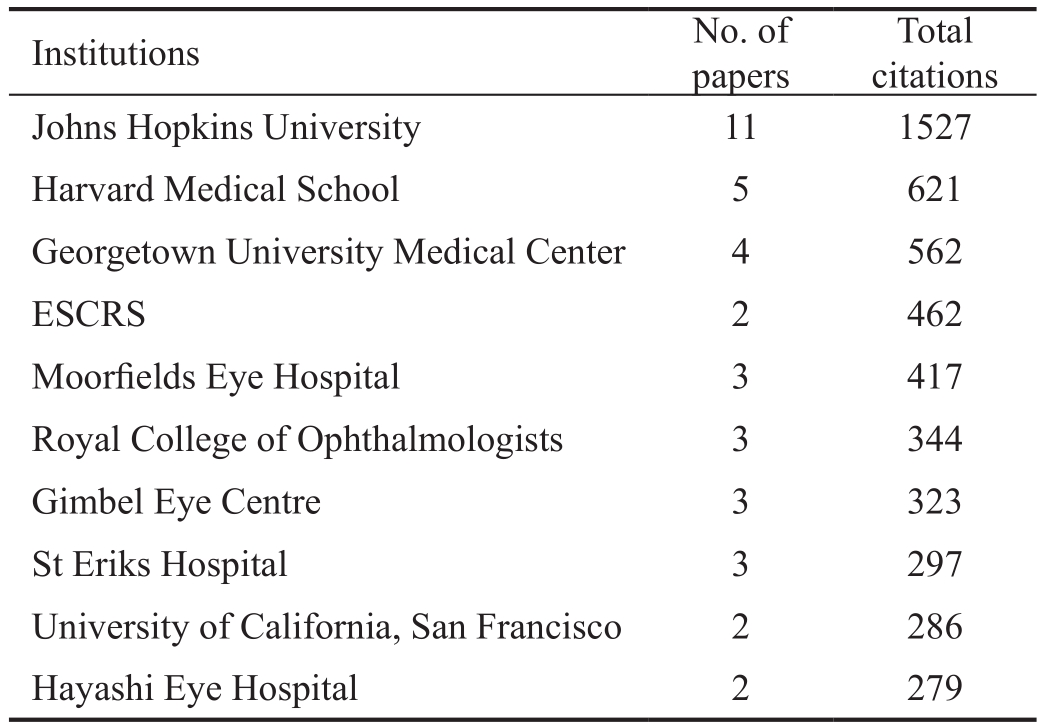
Table 7 Publication journals
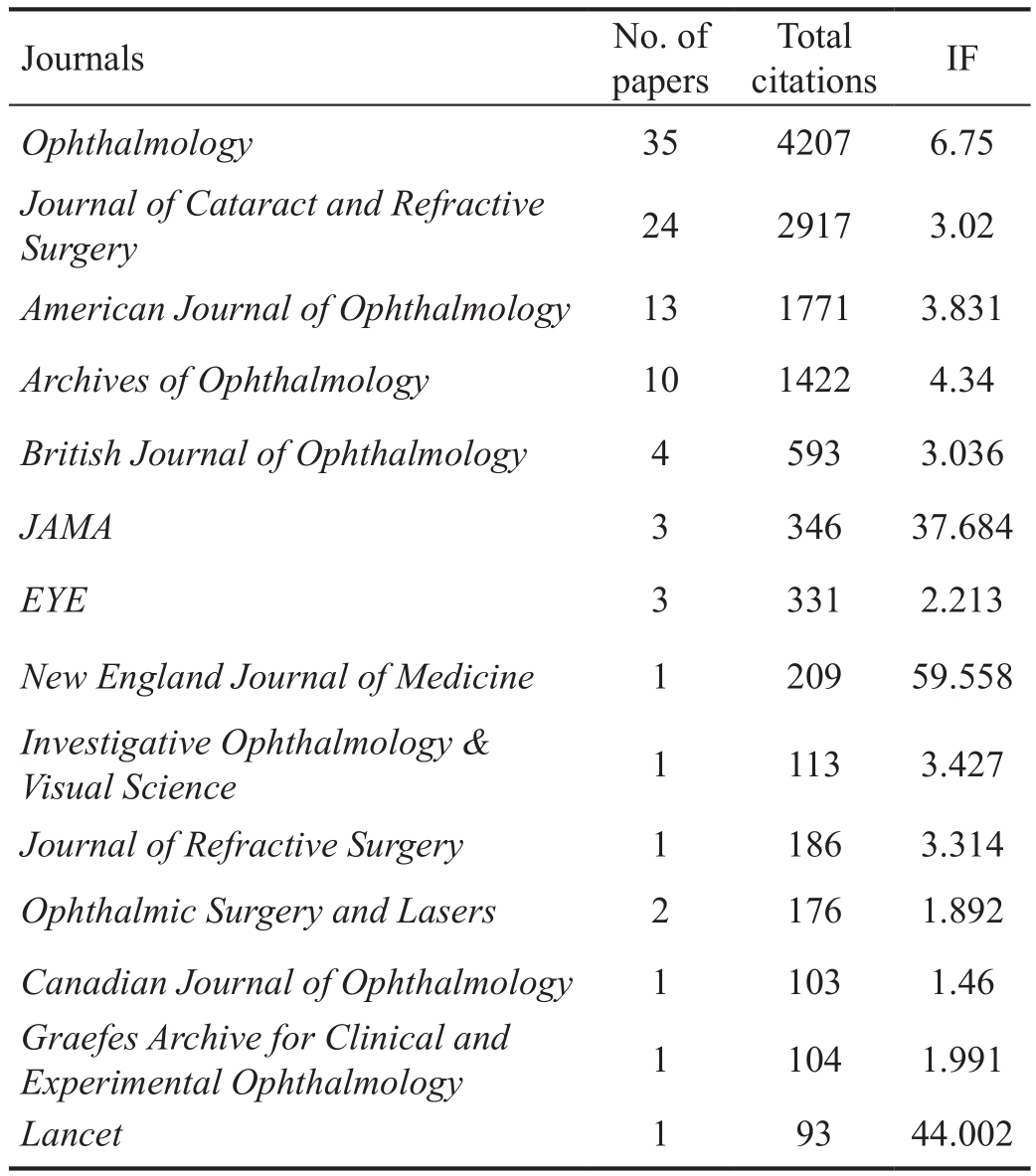
DISCUSSION
The most-cited paper is “Prophylaxis of postoperative endophthalmitis following cataract surgery: results of the ESCRS multicenter study and identification of risk factors” conducted by ESCRS Endothalmitis Study Group and published in the Journal of Cataract and Refractive Surgery in 2007[24]. This study focuses on investigating the risk factors and effects of antibiotic prophylaxis on the incidence of endophthalmitis after cataract surgery.This work is a prospective randomized partially masked multicenter study on cataract surgery led by ESCRS and suggests that prophylaxis, precisely the use of intracameral cefuroxime at the end of surgery, would reduce the incidence of postoperative endophthalmitis. However, the application of clear corneal incision (CCI) and silicone intraocular lens(IOLs) would increase the incidence of endophthalmitis after cataract surgery compared with the scleral tunnels and acrylic IOLs. Interestingly, the second most-cited paper on the list, entitled “Acute endophthalmitis following cataract surgery: a systematic review of the literature”, is also about endophthalmitis written by Taban et al[25] in 2005. This systematic review reports the incidence rate based on an extensive literature search and indicates that the increasing rate of postoperative endophthalmitis may be caused by the popular application of sutureless CCI. This conclusion coincides with the results from the former ESCRS study.Impressively, the topic of the third most-cited paper is also about endophthalmitis after cataract surgery. This review was written by Ciulla et al[30] and its conclusions supported that the use of antibiotic prophylaxis could decrease the incidence rate of endophthalmitis after cataract surgery[31].
There are common themes among many of the papers on this list (Table 3). On basis of our results, we rank the relative importance placed on the various research areas by cataract surgeons from 1950 to now. Postoperative complications,especially endophthalmitis, are the most attractive research areas of cataract surgery with 5768 citations, followed by the description of application of new surgical techniques, and the evaluation of surgical outcomes, with 2191 and 1960 citations respectively. These topics are most commonly seen in the research fields on cataract surgery.
Except two studies performed by the ESCRS, which includes many European countries[24,32], the rest 98 papers are attributed to a total of 14 countries. Among them, the USA with 58 papers ranks top undoubtedly with 7166 citations, followed by the UK with 14 papers, Japan with 4 papers, Germany with 4 papers, Sweden with 4 papers, Canada with 4 papers and the Netherlands with 2 papers. These seven countries are all from the developed world and have devoted high expenditure to the health care systems, which may contribute to their high performances in the rank list. Concerning the institutes of origin, the most commonly seen institutes were Johns Hopkins University and Harvard Medical School, with 1527 and 621 citations respectively. It might be owed to the Wilmer Eye Institute and the Massachusetts Eye & Ear Infirmary Affiliated to Johns Hopkins and Harvard. These two world famous eye research centers have done many excellent works, which impress the global ophthalmological community. The institutes that followed were the Georgetown University with 562 citations, ESCRS with 462 citations, Moor fields Eye Hospital with 417 citations, Royal College of Ophthalmologists with 344 citations, Gimbel Eye Centre with 323 citations, St. Eriks Hospital with 297 citations, UCSF with 286 citations and Hayashi Eye Hospital with 279 citations. It is very impressive to note that the Canadian Family-owned Gimbel Eye Centre outperforms many famous large public eye centers. The three papers contributed by Gimbel Eye Centre were all written by the famous ophthalmologist Prof. Gimbel[33-35], who is known as the cofounder of the continuous curvilinear capsulorhexis(CCC) with Thomas Neuhann. He also first reported the technique of Divide and Conquer nucleofractis Phaco in one of his 3 papers included in the top-100 list[34].
As was noted in our results, the top-100 list only concerns 14 journals. The journal with the largest number of influential papers is Ophthalmology, with 35 articles published between 1983 and 2011. These articles cover a wide range of topics,such as postoperative complications, surgical outcomes and surgery technical improvements. This journal also contributes the most citations of 4207. The journal that follows is Journal of Cataract and Refractive Surgery with 2917 citations. This journal also contributed the most cited paper in the top-100 list. It is striking that these two journals contributed more than half in the number of the total citations. The latest papers of these two journals included in the list were published in year 2011 and 2009 respectively.
The author contributing the most citations of 647 and the one providing the most papers are Prof. Javitt[36-39]. The top 2 to 5 authors with the most citations are P. Desai with 463 citations,O. D. Schein with 433 citations, E. P. Steinberg with 367 citations and H. V. Gimbel with 323 citations.
According to our analysis, most influential papers were published in 1980s and 1990s. Interestingly, no papers published in the decades of 1960s and 1970s are included in our study. Though this result may be caused by varied factors,we believe that the appearance and development of Phaco in cataract surgery may be the main reason. In 1967, Kelman[40]firstly applied Phaco in cataract surgery, and now it has become the most popular surgical type in this field. However,in the first few years, the high cost of Phaco machines and long-time training period for junior surgeons might strongly restrict the practicability and promotion of this revolutionary surgical technique. So we conjecture that most of the papers published in 1960s and 1970s are irrelevant to Phaco and are thus less likely to be citated in the following decades.
The result of the Pearson correlation analysis showed no significant correlation between the published year and the total number of citations, while we observed that the latest 5y citations and ACY were significantly associated with the published year. It may be owed to that people are much more willing to cite the recent papers with the newest and hottest research achievements published on them. In our observation,the journals’ IF had no meaningful effect on the total citations.It may be explained that the involved journals in our study were all with high quality in their professional fields.
Though we manage to identify the 100 most influential articles by ranking the citations, our bibliometric analysis may be restricted by some other factors, such as self-citation, and journal bias. However, the present study pays little attention to the control of these factors. There are also many phenomena that can impact citation analysis, including obliteration by incorporation and incomplete citing. These factors may restrict the applicability of this study.
To our knowledge, this is the first study to identify the 100 most influential papers about cataract surgery and provide ophthalmologists with a comprehensive bibliometric analysis.This study manages to provide valuable information about the development of cataract surgery between 1950 and 2016, and serves as a reference source in the arena of cataract surgery for ophthalmologists involved in further development of this surgery.
ACKNOWLEDGEMENTS
Conflicts of Interest: Lin ZN, None; Chen J, None; Zhang Q, None; Li Q, None; Cai MY, None; Yang H, None; Cui HP, None.
REFERENCES
1 Swenor BK, Simonsick EM, Ferrucci L, Newman AB, Rubin S, Wilson V. Visual impairment and incident mobility limitations: the health, aging and body composition study. J Am Geriatr Soc 2015;63(1):46-54.
2 Beaton K, McEvoy C, Grimmer K. Identifying indicators of early functional decline in community-dwelling older people: a review. Geriatr Gerontol Int 2015;15(2):133-140.
3 Pan CW, Liu H, Sun HP, Xu Y. Increased difficulties in managing stairs in visually impaired older adults: a community-based survey. PLoS One 2015;10(11):e0142516.
4 Pascolini D, Mariotti SP. Global estimates of visual impairment: 2010.Br J Ophthalmol 2012;96(5):614-618.
5 Keeffe J, Taylor HR, Fotis K, Pesudovs K, Flaxman SR, Jonas JB,Leasher J, Naidoo K, Price H, White RA, Wong TY, Resnikoff S, Bourne RR; Vision Loss Expert Group of the Global Burden of Disease Study.Prevalence and causes of vision loss in Southeast Asia and Oceania: 1990-2010. Br J Ophthalmol 2014;95(8):586-591.
6 Pizzarello L, Abiose A, Ffytche T, Duerksen R, Thulasiraj R, Taylor H,Faal H, Rao G, Kocur I, Resnikoff S. VISION 2020: The right to sight:a global initiative to eliminate avoidable blindness. Arch Ophthalmol 2004;122(4):615-620.
7 Zhao L, Chen XJ, Zhu J, Xi YB, Yang X, Hu LD, Ouyang H, Patel SH,Jin X, Lin D, Wu F, Flagg K, Cai H, Li G, Cao G, Lin Y, Chen D, Wen C, Chung C, Wang Y, Qiu A, Yeh E, Wang W, Hu X, Grob S, Abagyan R, Su Z, Tjondro HC, Zhao XJ, Luo H, Hou R, Jefferson J, Perry P, Gao W, Kozak I, Granet D, Li Y, Sun X, Wang J, Zhang L, Liu Y, Yan YB,Zhang K. Lanosterol reverses protein aggregation in cataracts. Nature 2015;523(7562):607-611.
8 Hejtmancik JF. Ophthalmology: cataracts dissolved. Nature 2015;523(7562):540-541.
9 Comstock TL, DeCory HH. Advances in corticosteroid therapy for ocular inflammation: loteprednol etabonate. Int J Inflam 2012;2012:789623.
10 Babizhayev MA, Deyev AI, Yermakova VN, Semiletov YA, Davydova NG, Kurysheva NI, Zhukotskii AV, Goldman IM. N-Acetylcarnosine,a natural histidine-containing dipeptide, as a potent ophthalmic drug in treatment of human cataracts. Peptides 2001;22(6):979-994.
11 Ashwin PT, Shah S, Wolffsohn JS. Advances in cataract surgery. Clin Exp Optom 2009;92(4):333-342.
12 Davis G. The evolution of cataract surgery. Mo Med 2016;113(1):58-62.13 Menapace R. Developments in modern cataract surgery-a critical overview. Ther Umsch 2016;73(2):53-59.
14 Debas HT, Donkor P, Gawande A, Jamison DT, Kruk ME, Mock CN. Essential surgery: disease control priorities. Third edition (volume 1). Washington (DC): The Internatinal Bank for Reconstruction and Development/The World Bank, 2015.
15 Lotfipour M, Rolius R, Lehman EB, Pantanelli SM, Scott IU.Trends in cataract surgery training curricula. J Cataract Refract Surg 2017;43(1):49-53.
16 Chadha N, Liu J, Maslin JS, Teng CC. Trends in ophthalmology resident surgical experience from 2009 to 2015. Clin Ophthalmol 2016;10:1205-1208.
17 Alkharashi M, Stark WJ, Daoud YJ. Advances in cataract surgery.Expert Rev Ophthalmol 2013;8(5):447-456.
18 Singh A, Strauss GH. High-fidelity cataract surgery simulation and third world blindness. Surg Innov 2015;22(2):189-193.
19 Tang Y, Wang X, Wang J, Huang W, Gao Y, Luo Y, Yang J, Lu Y.Prevalence of age-related cataract and cataract surgery in a chinese adult population: the Taizhou Eye Study. Invest Ophthalmol Vis Sci 2016;57(3):1193-1200.
20 Yan X, Guan C, Mueller A, Iezzi B, He M, Liang H, Meltzer M,Congdon NG. Outcomes and projected impact on vision restoration of the China Million Cataract Surgeries Program. Ophthalmic Epidemiol 2013;20(5):294-300.
21 Garfield E. The history and meaning of the journal impact factor.JAMA 2006;295(1):90-93.
22 Gar field E. The evolution of the science citation index. Int Microbiol 2010;10(1):65-69.
23 Irvine SR. A newly defined vitreous syndrome following cataract surgery. Am J Ophthalmol 1953;36(5):599-619.
24 Endophthalmitis Study Group. European Society of Cataract &Refractive Surgeons. Prophylaxis of postoperative endophthalmitis following cataract surgery: results of the ESCRS multicenter study and identification of risk factors. J Cataract Refract Surg 2007;33(6):978-988.
25 Taban M, Behrens A, Newcomb RL, Nobe MY, Saedi G, Sweet PM,McDonnell PJ. Acute endophthalmitis following cataract surgery: a systematic review of the literature. Arch Ophthalmol 2005;123(5):613-620.
26 Durand ML. Endophthalmitis. Clin Microbiol Infect 2013;19(3):227-234.
27 Yannuzzi NA, Si N, Relhan N, Kuriyan AE, Albini TA, Berrocal AM,Davis JL, Smiddy WE, Townsend J, Miller D. Endophthalmitis after clear corneal cataract surgery: outcomes over two decades. Am J Ophthalmol 2017;174:155-159.
28 Chang DF, Braga-Mele R, Henderson BA, Mamalis N, Vasavada A,Committee ACC. Antibiotic prophylaxis of postoperative endophthalmitis after cataract surgery: results of the 2014 ASCRS member survey. J Cataract Refract Surg 2015;41(6):1300-1305.
29 Tscharntke T, Hochberg ME, Rand TA, Resh VH, Krauss J. Author sequence and credit for contributions in multiauthored publications. PLoS Biol 2007;5(1):e18.
30 Ciulla TA, Starr MB, Masket S. Bacterial endophthalmitis prophylaxis for cataract surgery: an evidence-based update. Ophthalmology 2002;109(1):13-24.
31 Asencio MA, Huertas M, Carranza R, Tenias JM, Celis J, Gonzalezdel Valle F. Impact of changes in antibiotic prophylaxis on postoperative endophthalmitis in a Spanish hospital. Ophthalmic Epidemiol 2014;21(1):45-50.
32 Endophthalmitis Study Group. Prophylaxis of postoperative endophthalmitis following cataract surgery: Results of the ESCRS multicenter study and identification of risk factors. J Cataract Refract Surg 2007;33(6):978-988.
33 Gimbel HV, Neuhann T. Continuous curvilinear capsulorhexis. J Cataract Refract Surg 1991;17(1):110-111.
34 Gimbel HV. Divide and conquer nucleofractis phacoemulsification:development and variations. J Cataract Refract Surg 1991;17(3):281-291.
35 Gimbel HV, DeBroff BM. Posterior capsulorhexis with optic capture:maintaining a clear visual axis after pediatric cataract surgery. J Cataract Refract Surg 1994;20(6):658-664.
36 Javitt JC, Vitale S, Canner JK, Krakauer H, McBean AM, Sommer A. National outcomes of cataract extraction. I. Retinal detachment after inpatient surgery. Ophthalmology 1991;98(6):895-902.
37 Javitt JC, Vitale S, Canner JK, Street DA, Krakauer H, McBean M,Sommer A. National outcomes of cataract extraction. Endophthalmitis following inpatient surgery. Arch Ophthalmol 1991;109(8):1085-1089.
38 Javitt JC, Brenner MH, Curbow B, Legro MW, Street DA. Outcomes of cataract surgery. Improvement in visual acuity and subjective visual function after surgery in the first, second, and both eyes. Arch Ophthalmol 1993;111(5):686-691.
39 Javitt JC, Street DA, Tielsch JM, Wang Q, Kolb MM, Schien O, Sommer A, Bergner M, Steinberg EP. National outcomes of cataract extraction. Retinal detachment and endophthalmitis after outpatient cataract surgery. Cataract Patient Outcomes Research Team.Ophthalmology 1994;101(1):100-105.
40 Kelman CD. Phaco-emulsification and aspiration: a new technique of cataract removal: a preliminary report. Am J Ophthalmol 1967;64(1):23-35.